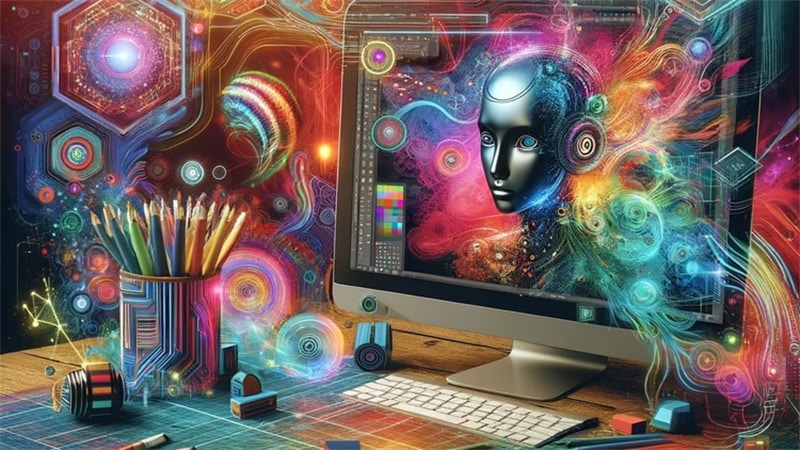The realm of design is undergoing a significant transformation, thanks to the advent of AI-driven design solutions. These innovative technologies are not only streamlining processes but also enhancing creativity and efficiency in ways previously unimaginable. For digital creators, understanding and leveraging these solutions is crucial to staying competitive in today’s fast-paced digital world.
From graphic design to architectural visualization, the influence of AI-driven design solutions is pervasive. This article delves into how these technologies are reshaping the design landscape and what it means for designers and creators alike.

The Rise of AI in Design
Artificial intelligence is no longer a futuristic concept; it is a present-day reality that is revolutionizing numerous industries, including design. The integration of AI into design processes allows for faster iterations, more personalized user experiences, and the ability to predict trends with remarkable accuracy.
AI in Graphic Design
In graphic design, AI is being used to automate repetitive tasks such as resizing images and adjusting colors, freeing designers to focus on more creative aspects. Additionally, AI tools can generate design suggestions based on user preferences and past projects, making the design process more efficient and tailored.
For more insights on how AI is influencing graphic design, you can visit HubSpot’s article on AI in graphic design.
Predicting Design Trends
AI-driven solutions are also capable of analyzing vast amounts of data to identify and predict emerging design trends. This capability is invaluable for designers who aim to stay ahead of the curve. By understanding what is likely to become popular, designers can create more relevant and timely work.
To explore this topic further, check out the insights on AI predicting design trends.
AI in Architectural Visualization
In the field of architectural visualization, AI is proving to be a game-changer. It allows for the creation of highly detailed and realistic renderings at unprecedented speeds. AI-driven tools can simulate lighting, textures, and even human interaction within spaces, providing architects and clients with a more immersive experience.
Further reading on AI’s role in this field is available at AI for architectural visualization.
3D Modeling and AI
AI is also making significant strides in 3D modeling. By using neural networks and machine learning algorithms, AI can generate complex 3D models quickly and accurately. This advancement is particularly beneficial in industries such as gaming and film, where detailed models are essential.
Learn more about this topic on AI for 3D modeling.
Benefits of AI-driven Design Solutions
Efficiency and Speed
One of the most significant advantages of AI-driven design solutions is the enhancement of efficiency and speed. By automating mundane tasks, designers can focus more time on conceptualization and creativity, leading to more innovative outcomes.
Improved Creativity
Contrary to the fear that AI might stifle creativity, it actually fosters it. By handling the technical aspects of design, AI allows creators to explore new ideas and experiment without the constraints of time-consuming tasks.
Data-Driven Decisions
AI provides access to vast amounts of data, enabling designers to make informed decisions based on analytics and trends. This data-driven approach ensures that designs are not only aesthetically pleasing but also aligned with market needs and user preferences.
Challenges and Considerations
Ethical Considerations
As with any technology, the use of AI in design raises ethical questions. Issues such as intellectual property rights, data privacy, and the potential for bias in AI algorithms must be carefully considered.
Skill Development
For designers, the rise of AI necessitates the development of new skills. Understanding how to work alongside AI tools and leverage their capabilities is essential for continued relevance in the industry.
The Future of AI in Design
Looking ahead, the role of AI in design will only continue to grow. As technologies evolve, we can expect even more sophisticated tools that further blur the lines between human creativity and machine intelligence.
For an in-depth understanding of how neural networks are contributing to this evolution, visit role of neural networks in design.
Conclusion
The integration of AI-driven design solutions into the creative process is an exciting development that promises to transform the industry. By embracing these technologies, digital creators can enhance their creativity, efficiency, and competitive edge in the ever-evolving design landscape.

FAQ
What are the benefits of AI in design?
AI in design offers numerous benefits, including increased efficiency, enhanced creativity, and the ability to make data-driven decisions. It allows designers to automate repetitive tasks and focus on more creative aspects.
How does AI predict design trends?
AI predicts design trends by analyzing large datasets to identify patterns and emerging preferences. This capability helps designers to anticipate changes in the market and create relevant designs.
What are the challenges of using AI in design?
Challenges include ethical considerations, such as data privacy and potential biases in AI algorithms. Designers also need to develop new skills to effectively work alongside AI tools.







